
The first time I encountered Duke Riley’s work was at Rockaway Beach in Queens taking place 10 years ago. He won third prize in a sandcastle competition for his sculpture of a White Castle decorated with shells, seaweed, and other natural materials he collected from nearby Dead Horse Bay.
The artist’s new show at the Brooklyn Museum also uses objects washed from the sea, but this time with less impact.
In “Death to the Living: Long Live Trash,” Riley makes a contemporary version of traditional maritime crafts, the trash he picks up on northeast beaches, such as elaborate ones made of washed plastic bottles, and toothbrushes reminiscent of scrimshaw engravings.
Contemporary works, which speak to the evils of pollution and single-use plastic, are displayed alongside the historic scrimshaw — which is also environmentally damaging. The works can be seen inside the period rooms of the Jan Martense Schenck and Nicholas Schenck Houses, built in about 1675 and 1775, respectively.
We talked to Riley about the importance of taking risks in art, and why having a water view is necessary for his studio.
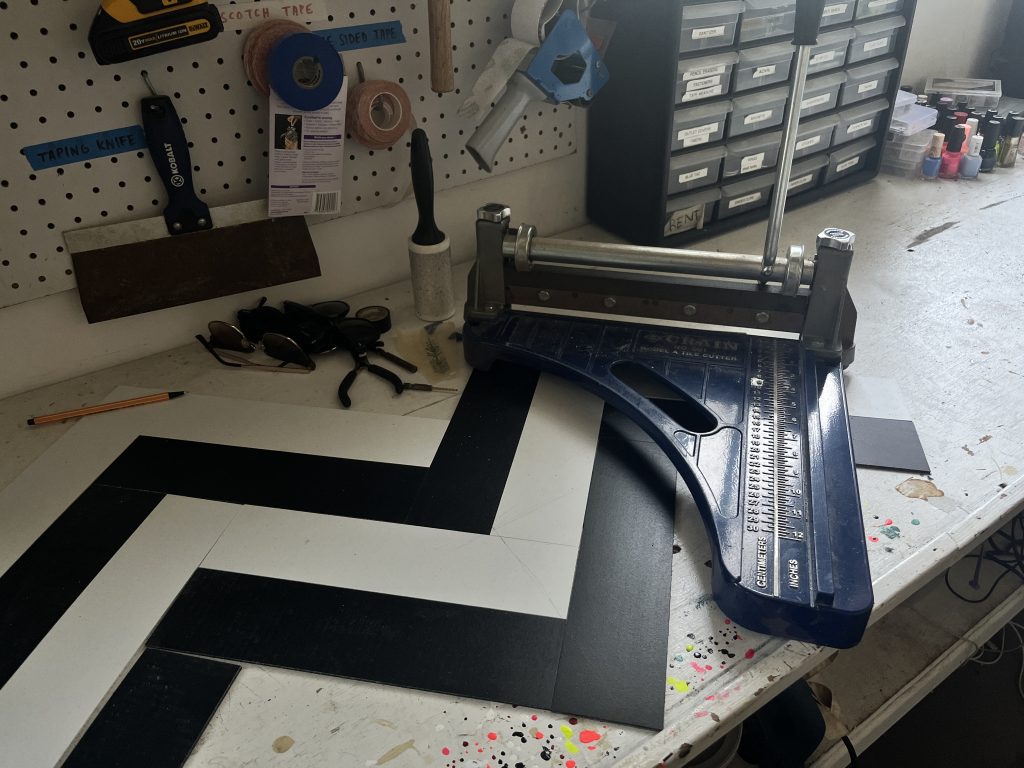
Duke Riley’s tile cutter. Photo courtesy of the artist.
What are the most important thing (s) in your studio and why can’t you live without it?
The tiles I use for Erika [mosaic] are tiles I’ve collected over the years from construction dumpsters as people tear them apart as they renovate buildings. I also got a lot when Bergen Tile closed on Flatbush Avenue in 2008.
What’s the studio work on your agenda this week that you’ve been waiting for?
Now that we spend a lot of time in the studio, we put energy into thinking about reselling royalties for artists. It is really possible for that to happen now, and it needs to happen. Other than that, we are working hard on building a pigeon coop. So far, we’ve added stained glass, new shingle, and corbels. This week, we’re adding solar panels. I’m also adding solar panels to my boat to set it up for tattooing this summer.
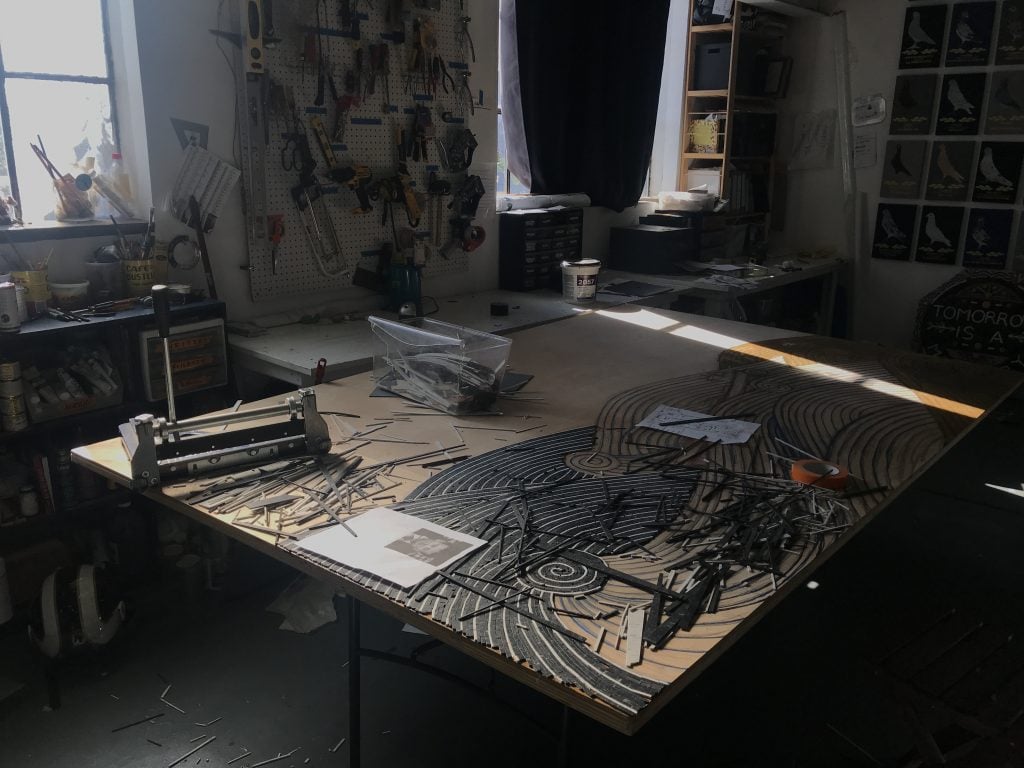
Currently working at Duke Riley’s Brooklyn Navy Yard studio. Photo courtesy of the artist.
What kind of environment do you like when you work? Do you listen to music or podcasts, or do you prefer silence? Why?
I can work through music, silence, books on tape, or just the news depending on what kind of work I’m doing. Different stimulation is needed for each type of work I do. I am very dyslexic so listening to audio books and news is one of the best ways to stay informed.
Who are your favorite artists, curators, or other thinkers who should be followed on social media today?
I try to avoid social media as much as possible so I like curators that like me, I guess? The best thinkers can be seen drinking at dive bars in the middle of the day. I notice Mel Chin, Mark Dion, Mary Mattingly, Dread Scott, Caldonia Curry (Swoon), and Hank Willis Thomas.
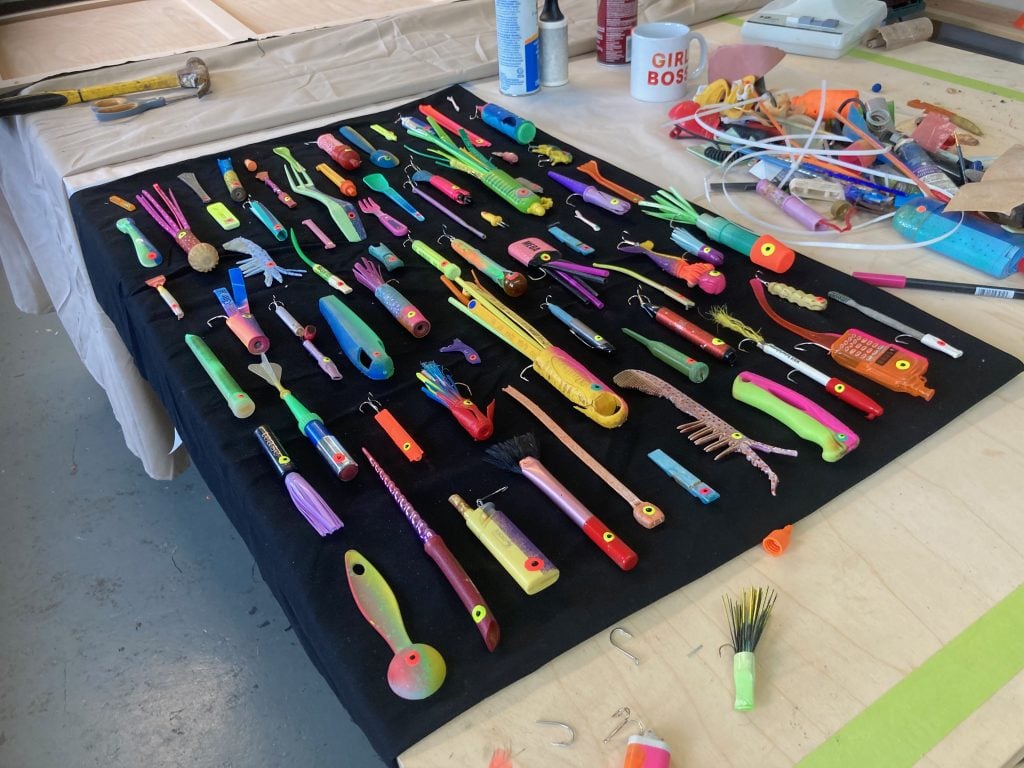
Duke Riley is currently doing fishing. Photo courtesy of the artist.
When you get stuck while preparing for a show, what do you do to not get stuck?
I’ve never really felt stuck while preparing for a show. When I feel like I’m exhausted from drawing, I move on to video making. When I’m exhausted with video, I move on to making a scrimshaw or a sculptural project.
What quality do you admire most in a work of art? What trait do you dislike the most?
I admire when artists are fully committed to the work and take risks. As Oscar Wilde said: “An idea that is not dangerous does not deserve to be called an idea at all.”
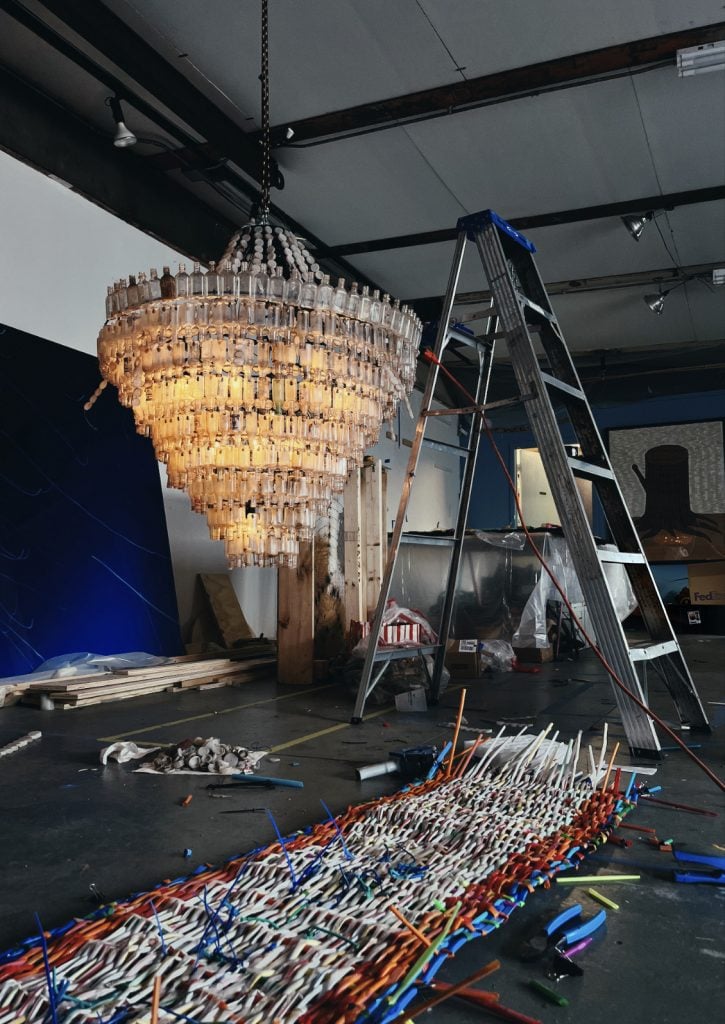
Currently working at Duke Riley’s Brooklyn Navy Yard studio. Photo courtesy of the artist.
What images or objects do you look at while you work? Share your view from behind the canvas or on your desktop — wherever you spend the most time.
Almost the entire time I work in New York, even when I’m using the boat as my studio in Red Hook or here at Navy Yard, I can see the water from where I am. working. I can say this is more important to me than the size of the space or having working heating.
What was the last exhibition you saw that impressed you and why?
The last exhibitions I saw that impressed me were Robin Frohardt’s “Plastic Bag Store” and Faith Ringgold’s show at the New Museum. I look forward to Charles Gaines ’project The American Manifest finally fulfilled this month.
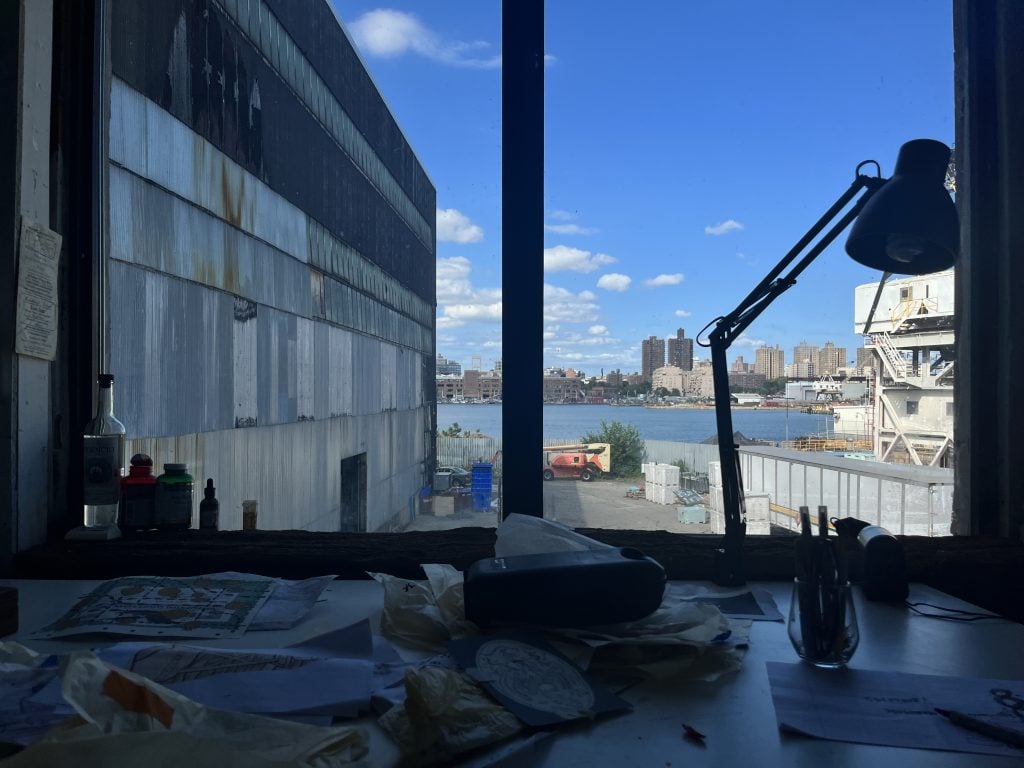
View from Duke Riley’s Brooklyn Navy Yard studio. Photo courtesy of the artist.
What is the reason why you chose this particular studio over others?
I first came to this studio in 2016 when we scouted locations for Fly at night and it is opposite where the project took place. While I was there, I met Marc Agger who runs Brooklyn Fish Transfer. We both have this connection to the seafood industry and the Massachusetts coast. He also loved art and we quickly became friends. I was fired from my Red Hook studio and he offered me the artist’s long -term residency at Agger Fish. The building we are in was once used for making submarines during World War II, so it seems to be intentional.
Describe the space in three adjectives.
Freezing cold, boiling hot, sometimes pleasant!
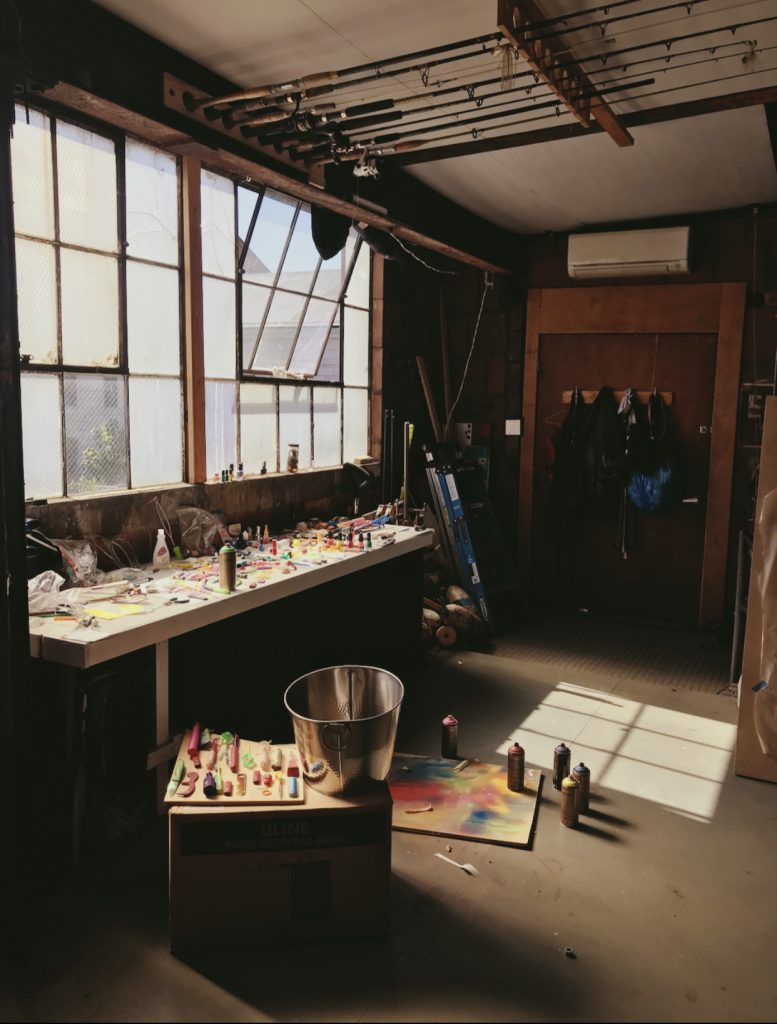
Duke Riley’s Brooklyn Navy Yard studio. Photo courtesy of the artist.
How does the studio environment influence the way you work?
During the summer I try to spend as much time outside the studio as possible. The studio is on the top floor of a building with no insulation. Instead, I use the small boat as a floating studio throughout the summer where I make most of the scrimshaw bottles. I worked that way over and over for years. Working on the boat, which is completely surrounded by water, and making the pieces in the way they were originally created certainly had an impact on the work and how I feel about the act of creation.
“Death to the Living: Long Live Trash” will be on display at the Brooklyn Museum, 200 Eastern Parkway, Brooklyn, June 17, 2022 – April 23, 2023.
Follow Artnet News on Facebook:
Want to stay ahead of the art world? Subscribe to our newsletter to get breaking news, eye-opening interviews, and critical critical steps driving the conversation.


